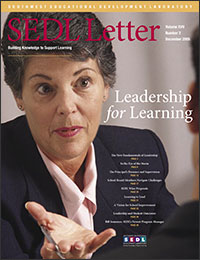Learning to Lead: Educators Use Their Summers for Research as Part of SEDL's Fellowship Program
According to the New Mexico Public Education Department, 4,500 of the 93,000 students enrolled in the Albuquerque public school system are American Indian. This number could be much higher; studies show that three out of every 10 American Indian students drop out of high school, a figure twice the national average. These students also tend to drop out at a younger age than students of other ethnic groups and score lower on standardized tests in New Mexico than any other ethnic group.
Kara Bobroff, a former middle school principal at a Navajo reservation who has also worked as a teacher and assistant principal in Albuquerque, witnessed the difficulties the public school system has in reaching out to American Indian students. She formulated a plan to create a charter school that will serve grades 6–12 and address the needs of the urban American Indian student population. This summer, she spent a month in Austin, Texas, as part of SEDL’s Education Leaders Fellowship Program in order to study available research and data to help her with the application. She hopes to open the school in Fall 2006; the application is currently pending approval.
SEDL fellows are educators who use their summer vacations to deepen their knowledge of research findings related to student achievement. The fellows work on individual projects with SEDL staff members at the organization’s headquarters.
“As a principal, you get so busy in day-to-day work,” Bobroff says. “Having a solid month to dedicate yourself is a good opportunity.”
Meeting Students’ Needs
Bobroff has served as a SEDL fellow twice. Two years ago, as assistant principal at Newcomb Middle School in Shiprock, New Mexico, she spent her fellowship in Austin developing a data management plan for a reading intervention program at her school. This year, she focused on designing the critical components of the proposed charter school. With a focus on both academic and social/emotional needs, the school will incorporate cultural awareness and wellness issues while including the community as a whole.
“There’s a real need to teach American Indian kids about the culture and about the languages that are spoken around them,” says Sebastian Wren, a program associate at SEDL who worked with Bobroff during her fellowship. “Schools need to connect to and embrace the surrounding culture.”
One of the founding principles of the school is the idea that students must be skilled readers in order to succeed. Bobroff worked with Wren to develop a reading program designed to help struggling readers. The school will address other issues affecting the American Indian population, such as obesity and diabetes. The overall framework of the school focuses on four different aspects of wellness: physical development, intellectual development, relationship development, and social/emotional development. Bobroff plans to involve the community in each aspect.
“Everything needs to have a community connection,” Wren says. “If they don’t have a good connection to the community, kids have a tough time developing into healthy students and healthy citizens.”
Bobroff found her experience as a SEDL fellow beneficial at this stage in the planning. She says that being able to bounce ideas off other people made her think about things in new and different ways. “It’s a way to do some concentrated work with a mentor who’s a specialist in the area,” Bobroff says. “It takes you out of your element for some in-depth study.”
Mastering Leadership Skills
Annesa Thompson, principal of Marked Tree High School in Marked Tree, Arkansas, also came to Austin this summer as a SEDL fellow. Thompson, who was accepted in the state-sponsored Master Principal Program last year, worked with SEDL staff to develop her portfolio in order to apply for the second phase of the program. The research-based program is designed to develop the leadership skills of principals. “The fellowship gave me the opportunity to assess where my school was on an improvement continuum and allowed me to network and develop next steps for the school as well as for myself professionally,” says Thompson, who worked with SEDL staff for 4 years as part of SEDL’s intensive site work in Marked Tree.
Program associate Ann Neeley says Thompson has made great strides under the Master Principal Program. She noted that the students’ test scores increased over the course of the year.
“It’s a very intensive program similar to our work,” Neeley says. “What’s so exciting is everything seemed to accelerate. Annesa was putting many things into action. The faculty meetings became professional development sessions where everyone could collaboratively share and learn.”
According to the Arkansas Department of Education, test scores rose in every area. The school also met adequate yearly progress requirements in both areas tested (math and literacy).
“I credit much of our improvement to the partnership formed with SEDL and especially through the individual efforts of SEDL staff members. They helped me understand the components necessary for improvement and supported me as I began to lay the foundation,” Thompson says.
Thompson spent her time in Austin studying how she could continue this progress over the course of the next year. She consulted various SEDL staff members in order to obtain their input and ideas.
“One of the things about school improvement is you cannot isolate yourself. You have to network,” Neeley says. “Annesa took full advantage of the people here. Being a principal can be lonely even though you’re surrounded by people. You need people with whom you can respond.”
Her work paid off. Thompson was one of 18 Arkansas educators accepted into the Master Principal Phase II program.
“The fellowship was the most valuable professional experience I have ever had the opportunity to participate in,” Thompson says. “My knowledge of school improvement and systemic change catapulted through the rich conversations and networking with the individuals there.”
Next Article: A Vision for School Improvement

